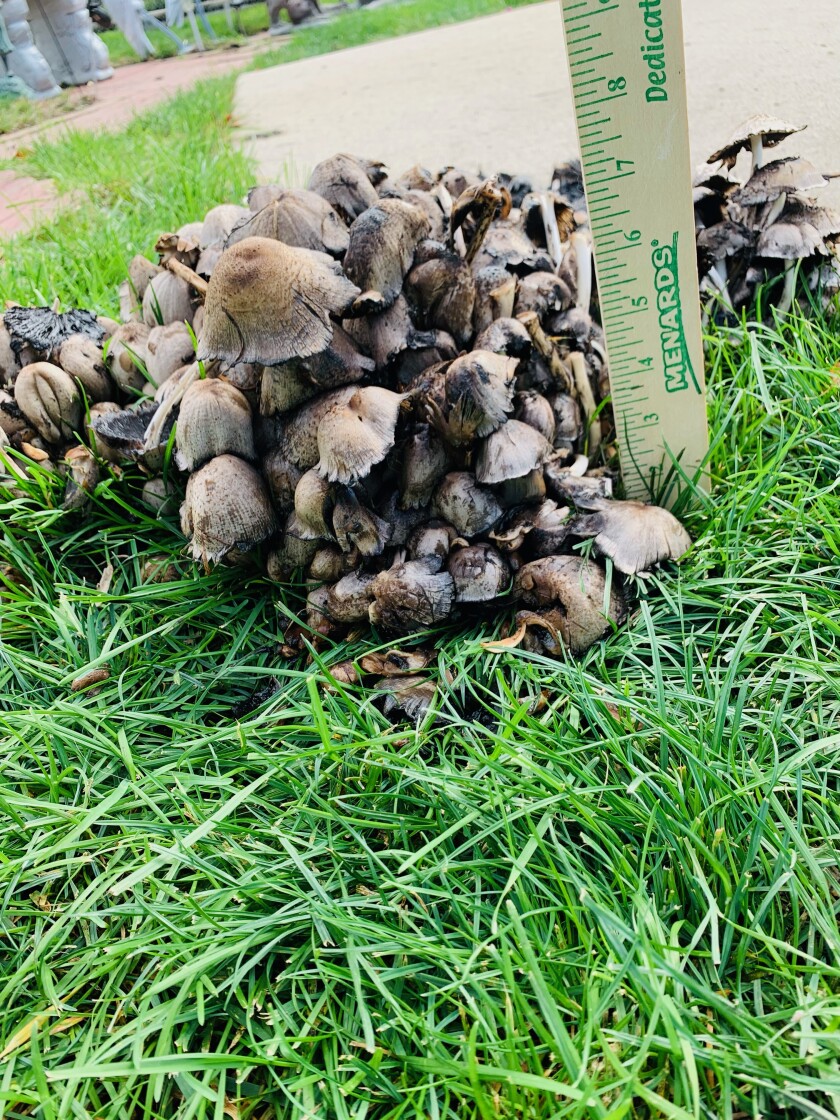Q: The big mushroom cluster in the photo kept getting bigger and bigger in October! What is it, and why so much? — Anne B.
A: Wow! That’s one big mushroom cluster.
ADVERTISEMENT
Mushrooms are fungi whose main structure, the rootlike mycelia, is below ground living on decaying organic material like old stumps, tree roots, buried chunks of lumber or decaying turf thatch. The larger the underground organic source, the larger the mushroom cluster tends to be.
The visible mushrooms that appear are the “fruiting bodies” which produce propagation spores. Most mushrooms don’t harm lawns or landscapes, and they’re helping to decay organic material which releases nutrients into the soil.
When mushrooms appear, it’s best to just rake them off and dispose in the trash. Digging usually doesn’t work, as the threadlike underground mycelia often extend beyond reach. There are no sprays or products that will effectively kill or prevent mushrooms without harming lawn and landscape.
I’m often asked to identify mushrooms, which I decline because some types are deadly, and the possibility of miscommunication is too great. The University of Minnesota Mycology Club has created a series of flashcards that can be used by those wishing to self-identify the various mushrooms found in the Upper Midwest. The card set can be downloaded at .

Q: I enjoyed Do you know how old a houseplant can get? I have a pothos that I got when I was in the hospital having my son, who is going to be 40 years old next year. I have repotted it many times, cut off the vines and put them in water until they grow roots and then potted them. The plant shows no sign of letting up. I just water it and occasionally give it some liquid plant food. I just don’t have the heart to pull it up and toss it out. I’m quite certain I will pass on before the plant does. Is this unusual? — Ell M.
ADVERTISEMENT
A: I’ve asked readers in the past to send stories about long-lived houseplants, and I received many reports of plants reaching a ripe old age. Among them were several Christmas cactuses with documented histories well over a hundred years.
Plants of that age are unusual, of course. An average length of time a plant is kept by its owner is probably between five and 15 years. Unlike humans, most houseplants don’t inevitably suffer old-age infirmities, and are theoretically capable of living forever.
Also unlike humans, most houseplants can be kept going perpetually by dividing them into new portions or coaxing a piece to form new roots. Your pothos can live indefinitely by propagating new cuttings, as you’ve done.
RELATED COLUMNS:
Q: I’ve tried rooting geranium cuttings in water, but they usually rot. You’ve mentioned another method in the past. Could you remind me what it was? — Kathy L.
A: Although geraniums cuttings can be rooted in a glass of water, rooting them in a mixture composed of half sand and half peat moss is usually more successful. They’re less likely to rot, and the roots formed are stronger and better-branched than roots that form in water.
Roots formed in a solid medium adapt more readily when transplanted into potting mix, compared to roots that form in water, which require a greater adjustment. Although the peat-sand mixture is my preferred method, I’ve had good success using high-quality potting mixes that are composed primarily of peat moss and aggregates like perlite and vermiculite.
ADVERTISEMENT
Geranium cuttings can be rooted in the peat-based media in recycled cell-packs or small pots. When roots are several inches long, or fill the cells, they’re ready to transplant into 4-inch diameter pots.
Geraniums can be successfully propagated any time of year, but late August is an ideal time to start cuttings that will produce perfect-sized plants by outdoor planting time the following spring. They can still be started in winter, but be certain to hasten the cuttings along, once rooted, with plenty of light, monthly fertilizing until February, and then increasing to twice monthly.
If you have a gardening or lawn care question, email Don Kinzler, NDSU Extension-Cass County, at donald.kinzler@ndsu.edu. Questions with broad appeal may be published, so please include your name, city and state for appropriate advice.











